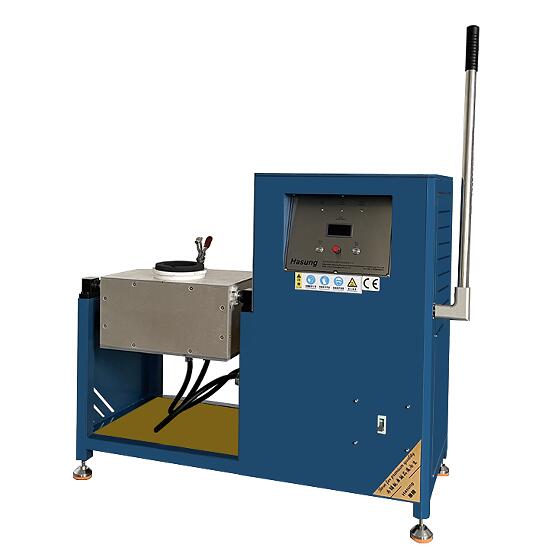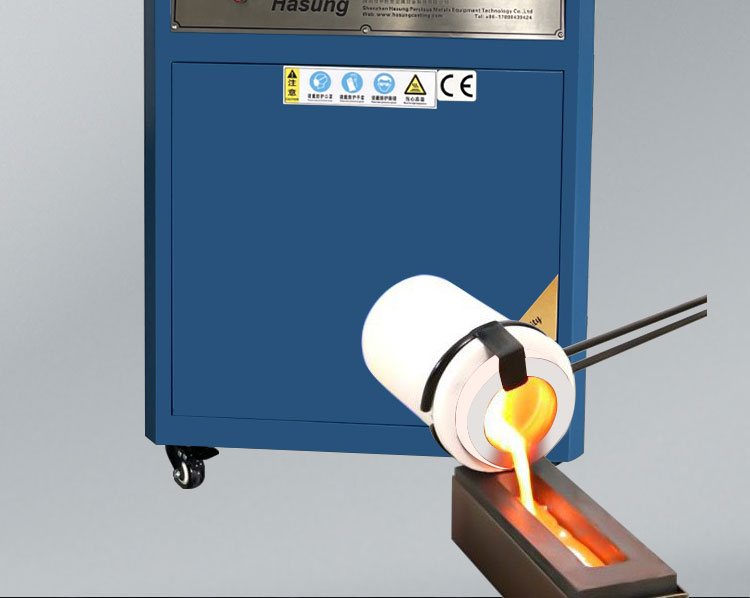Induction melting furnace is a commonly used metal melting equipment, which heats metal materials to the melting point through the principle of induction heating, achieving the purpose of melting and casting. It’s working on gold, but for precious metals, it’s highly recommended to use Hasung precision induction melting furnace.

This article will provide a detailed introduction to the principle and working process of an induction melting furnace.
1. The basic principle of induction melting furnace
The basic principle of induction melting furnace is to use the principle of electromagnetic induction for heating.
When high-frequency alternating current passes through a coil, an alternating magnetic field is generated.
When metal materials enter this magnetic field, eddy currents are generated.
Eddy currents generate a reactive force inside the metal that hinders the passage of current, thereby causing the metal material to heat up.
Due to the high electrical resistivity of metals, eddy currents are mainly concentrated on the metal surface, resulting in better heating effects.
2. The structure and working principle of induction melting furnace
The induction melting furnace is mainly composed of induction coils, power supply, melting chamber, and cooling system.
An induction coil is a coil wound around the furnace body, which is powered by a high-frequency power source and generates a high-frequency alternating magnetic field.
A melting chamber is a container used to place metal materials, usually made of high-temperature resistant materials.
The cooling system is used to maintain the temperature of the smelting furnace and prevent overheating of the furnace body.
The working principle of an induction melting furnace is as follows: 1. Put the metal material into the melting chamber, then turn on the power to power on the induction coil.
High frequency current generates a high-frequency alternating magnetic field through an induction coil. When a metal material enters the magnetic field, eddy currents are generated, causing the metal material to generate heat.
As heating proceeds, the metal material gradually reaches its melting point and melts.
The melted metal can be cast or processed by pouring or other methods.
3. The advantages and applications of induction melting furnaces
Induction melting furnaces have the following advantages:
1. Fast heating speed: Induction heating is a fast heating method that can heat metals to their melting point in a short period of time, improving production efficiency.
2. Uniform heating: As induction heating is local heating, it can evenly heat the metal material, avoiding thermal stress and deformation.
3. Low energy consumption: Due to its efficient heating method, induction melting furnaces can maximize energy utilization and save energy.
Induction melting furnaces are widely used in fields such as metal smelting, casting, and heat treatment.
For example, it is used to cast various metal products, such as copper, aluminum, iron, etc.
In addition, induction melting furnaces can also be used for melting alloys, melting glass, and so on.
4. The development trend of induction melting furnaces
With the development of technology, induction melting furnaces are also constantly improving.
At present, some induction melting furnaces have functions such as automation control, constant temperature control, and energy recovery.
The application of these new technologies not only improves production efficiency, but also reduces energy consumption and reduces environmental pollution.
In addition, some new materials have also played a promoting role in the development of induction melting furnaces.
For example, the application of high-temperature superconducting materials enables induction melting furnaces to operate at higher temperatures and melt a wider variety of metals.
Post time: Mar-05-2024












